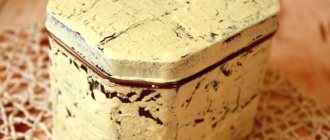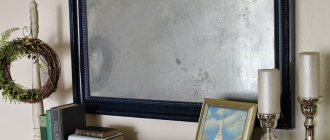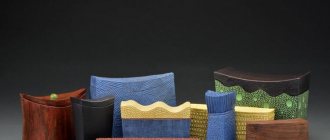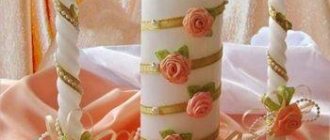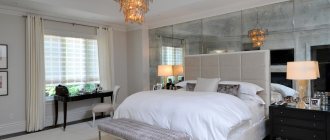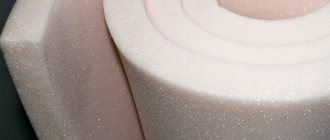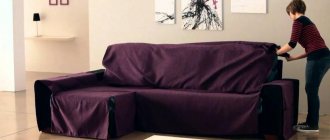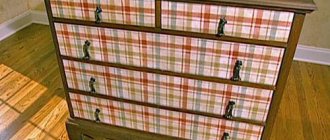0
14438
A mirror is a must-have item in any home, which can be used in the bathroom, bedroom, or hallway. Manufacturers offer many design options to suit every taste. But you can get a unique design element by assembling a backlit mirror with your own hands according to a ready-made or individual drawing. This requires skills in working with tools, time and some materials.
Backlight functions
Mirror lighting is a fairly new and alien element for most Russian homes, since its meaning still remains mysterious. In reality, everything is quite simple - the lamps edging the mirror perform two main tasks:
- decorative. Decorating lamps are usually located on the outside of the mirror or on the sides, but there are exceptions. There are many possible options for the placement of these lamps and even the shades of the glow themselves - it can be not only light yellow, but also blue, orange, pink and so on. Such freedom in handling lighting allows you to skillfully fit it into any interior;
The backlight can frame the mirror in the form of a shining frame, giving it an element of fabulousness.
- utilitarian. In addition to decorating the room, lamps allow you to achieve proper lighting, which is especially typical for the so-called “makeup artist mirrors,” the peculiarity of which is that there is a row of bright lamps along the entire frame. This type of lighting was initially in demand in professional circles - among make-up artists, hairdressers, stylists, as it made it possible to see all the details of the skin and hair. Now similar mirrors are appearing in the home environment.
In bathrooms, lighting should be aimed primarily at achieving a clear reflection
It should be noted that these two functions are by no means mutually exclusive - illuminated mirrors can combine both practicality and beauty, adding variety even to austere interiors. At the same time, you need to take into account that some types of mirrors, such as a makeup artist’s mirror, are actively used in loft style and look very harmonious in it.
Main conclusions
Do-it-yourself illumination of a bathroom mirror using an LED strip allows you to decorate the room and complement its interior with a stylish and effective element. Installation and installation of lighting is not fundamentally difficult; all that is required is care and thoroughness in performing all operations.
The result will not only decorate the room, but will also make using the mirror more convenient, improve visibility, and improve the quality of all hygiene procedures. If you have your own options for making the backlight, you can outline them in your comments. Both experienced and novice craftsmen need new ideas.
Previous
LEDsTechnical characteristics and features of choosing two-pin LED lamps for cars
Next
LEDsHow to measure and improve LED efficiency
Backlight types
Today there are three main types of lighting that are most suitable for mirrors:
- halogen lighting;
- neon lighting;
- LED lightening.
Halogen lamps
In their way of operation, such lamps are in many ways reminiscent of incandescent lamps - their only difference is that they are filled with gas inside. The strengths of halogen lamps are their low energy consumption and reliability, making them suitable for installation in bathrooms.
Halogen lamps are an economical and practical solution for all rooms
Neon lamps
Neon type of lighting has gained popularity due to its high light output. However, when installing such lamps, it is important to keep in mind that you can quickly get tired of the rich and bright light, so you should think about their proper placement in advance. A “softer” option, which is an alternative to neon lighting, is considered to be fluorescent lamps that emit a diffuse and delicate glow.
Neon lamps, due to their power, may not be suitable for every apartment owner
LED bulbs
LED lighting is very often used these days as backlighting in bathrooms, living rooms and hallways due to its versatility. It combines low power consumption and intense glow. Lamps of this type are often located behind a mirror, resulting in a spectacular diffused glow. Of course, this option is far from the cheapest, but its cost is paid off by the length of the “service”.
LED lamps are often installed at the top of the mirror, without affecting its sides
Accommodation options
Built-in mirror lighting around the perimeter
The location of the light sources affects the uniformity of lighting. Lamps for external lighting are placed on the sides of the canvas, top, bottom or along the perimeter of the frame. Installing lamps around the perimeter is used for makeup mirrors, since this arrangement allows you to illuminate all areas of the face in detail.
The illumination of tall mirrors in hallways and corridors is made from six or more sources, evenly distributed along the sides. A smaller number of sources does not provide bright illumination in height.
The built-in lighting is made of LED strips, which are mounted on the back side of the canvas along the perimeter edge. The reflective coating is removed from the LED installation line, and the resulting transparent windows are covered with a matte film.
For decorative lighting equipment, white and colored RGB LED strips are used, which are embedded under a reflective sheet or mounted externally on a frame or glass. 3D designs of two parallel reflectors with an LED strip located along the contour between them are popular.
DIY illuminated mirror
Since the market for illuminated mirrors is extremely diverse, we will not be able to give universal instructions for creating such a product. Moreover, all mirrors differ in their “level of complexity”. Of course, there are options that even a person who is superficially familiar with a drill can handle, but some models equipped with touch buttons and a complex internal lighting system require the hands of a professional.
Therefore, before setting out to make such a structure yourself, it is important to correctly assess your strengths. In this chapter, we will talk about how to make a classic makeup artist mirror and a mirror with internal LED lighting, suitable for hallways and bathrooms.
DIY makeup artist's mirror
Step 1. In order to make a backlit mirror, prepare boards, a hammer drill, light bulbs and a socket, an example of which will be shown in the photo below. The function of the sockets is to subsequently insert them into the mirror frame and screw the lamps into them.
The reliability of the lamp socket depends on the quality of the socket.
Step 2. Measure the boards and cut them with a saw (the dimensions of the mirrors can be very different - from two meters to 70-80 centimeters - depending on your goals).
Sawing boards
Processing result
Step 3. Glue the resulting beams first with assembly glue and then with a stapler. A stapler allows you to easily connect boards and make the fastening more reliable by securing the adhesive base. In order to give the structure additional reliability, you can also fasten it with a stapler from the end. If desired, you can use self-tapping screws instead of a stapler and paper clips.
Gluing the future mirror frame with mounting glue
Fastening boards using a construction stapler
Stapler prices
Construction stapler
Step 4. Repeat this procedure with the remaining three joints and give the structure time to dry.
Finished frame blank
Step 5. While the base is drying, start marking the points where the lamps will be located in the future. To do this, you will need to measure the entire length of the boards and decide on the number of light bulbs. Various options for placing lamps are possible, but in this case we will place an equal number of lamps on each side - three pieces.
Measuring boards
Step 6: Measure the width of one of the vertical boards and mark the middle with a pencil. This point will later be used to drill holes. Follow this simple procedure for all other lamps.
Determining points for future holes for lamps
Step 7. Take a drill pen, insert it into the drill and drill all the marked points. This action should be carried out very carefully, since feathers tend to destroy the boards on the reverse side.
The diameter of the pen for drilling must be equal to the diameter of the intended hole
Drilling process
Final result
Step 8. Process the resulting holes from the front side using sandpaper. Of course, the washer will cover the holes, but this stage will make the base for the mirror more aesthetically pleasing and safer (in terms of accidental splinters). You should also sand all the ends (both on the outside and on the inside) so that they become less sharp.
Sanding the workpiece involves processing both the holes and the frame itself
Step 9: Paint the base using spray paint. It is advisable to paint in several layers so that the color is more saturated.
The frame is painted using an aerosol spray.
Step 10. Understand the design of the cartridge. The cartridge has a part on which there are two holes on the sides, designed to thread wires through them. Subsequently, this part is removed inside the cartridge. Using a screwdriver, unscrew this one, insert the wires into it and screw it back in to secure them.
The wires should go through two small holes
Unscrewing and tightening of the part is carried out using a screwdriver
Threading wires
Step 11: Assemble the socket and repeat this procedure for each individual light bulb. On average, this stage takes about thirty minutes. Part of the total length of the wire should be unused, since it will subsequently be used to install the switch.
Chuck assembly
The final result of parallel connection of cartridges
Step 12: Insert the cartridge washers into the holes in the frame.
Washers spaced along the entire length of the frame
Step 13. Screw the wires into the back of the mirror frame, securing them with a stapler.
To ensure that the wires do not protrude beyond the frame, they should be stapled
Step 14. Take the switch and disassemble it by inserting it into the inner part of the wire - top and bottom. It is advisable to place the switch in one of the lower corners of the frame - this way it will be the least noticeable and most convenient to use.
Disassembled switch
Step 15: Assemble the fork. If desired, you can skip these two steps by purchasing a ready-made switch and plug.
Purchasing a plug and switch will make the process of assembling the mirror easier
Step 16. Screw the lamps into the sockets from the front side of the frame and check their operation.
Checking lamp operation
Step 17. Insert the mirror into the frame.
Finished mirror with external lighting
Insert the wires into the sockets
We should talk about conducting “electricity” in more detail. In this case, we are dealing with a parallel connection, in which we will need to connect all the other cartridges in such a way that they ideally fit into the holes prepared for them, along with the wires.
Step 1. After you insert the wires into the first socket, measure the distance between the holes and make several cuts on the wire accordingly.
The measured distance should correspond to the gap between the cartridges on the frame itself
Step 2. Place a knife between the wires and draw a line.
The cut must be made carefully so as not to touch the wires themselves.
Step 3: Carefully remove the wires and strip them. After removing the protection, expose the wires. Exposure can be done either with a lighter or with an ordinary knife. You can also purchase a special tool designed for working with wires at a hardware store.
Exposed wires
Step 4. Straighten the wires and twist them, then insert them into the socket. There is no order in which a particular wire must go into a particular hole.
The wires are inserted into the cartridge in a twisted form
Step 5: Assemble the cartridge.
Assembled cartridge
Wall mounting methods
The main requirement for fastening is strength. Massive metal and wooden frames weigh the most, so their fixation should be approached with special responsibility. Before you make a backlit mirror with your own hands, you need to keep the following in mind:
- Special holders, construction adhesive, liquid nails and mounting tape are only suitable for products with LED backlighting and a plastic frame.
- If the mirror is particularly heavy and large, the ideal option is mounting plates with holes into which screws are screwed.
- One of the most reliable methods of fixation is using a dowel: it is fixed in the wall, and loops are installed for hanging.
- If the floors in the house are concrete, you will need an electric drill to drill holes.
Purpose of a mirror with light bulbs, recommendations for manufacturing
As for the make-up model, there are no problems with fastening at all. This type of mirror is usually portable and small in size. It is placed on the table at which a woman applies makeup and combs her hair, in any room. If you need to rearrange the furniture, the glass in the frame, along with the shelves for toiletries, is carefully removed and then placed in a new place in the apartment. This is very convenient, especially when moving.
To make a backlit mirror more stable with your own hands (especially if the floor in the room is uneven), you should install a small wooden plank at the top of the back side of the base. It serves as a spacer that protects the interior item from falling and swinging. For safety reasons, if the glass is in a child's room, it is preferable to use wall mounts. The product in the frame is slightly tilted. The fittings are placed at a height of approximately 15 cm. They are screwed into the concrete using dowel nails.
If the master decides to use construction dowels to fix the mirrors with his own hands, he will additionally need small oval (round) plastic spacers and metal brackets. Screws must have flat heads. This fixation scheme is convenient and durable, with increased resistance to vibrations. It is ideal for thick, massive concrete walls.
The substrate must support the weight of the mirror. Most often it is made from plywood or chipboard. This material does not look very attractive, but is durable and therefore ideal for backdrops.
Construction adhesive, liquid nails and mounting tape can only be used for products with a plastic frame.
Large, heavy mirrors are secured with special plates with holes that are fixed with self-tapping screws
One of the most reliable methods of fixation is using a dowel fixed in the wall
If your house has concrete walls, you will need an electric drill to drill the holes.
A dressing room mirror is usually portable and small in size; if necessary, it can be installed in any room


